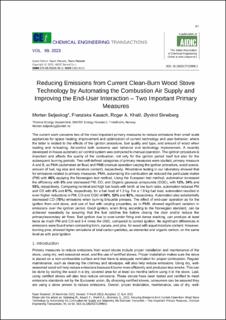Reducing Emissions from Current Clean-Burn Wood Stove Technology by Automating the Combustion Air Supply and Improving the End-User Interaction - Two Important Primary Measures
Peer reviewed, Journal article
Published version
Permanent lenke
https://hdl.handle.net/11250/3115201Utgivelsesdato
2023Metadata
Vis full innførselSamlinger
- Publikasjoner fra CRIStin - SINTEF Energi [1649]
- SINTEF Energi [1773]
Sammendrag
The current work concerns two of the most important primary measures to reduce emissions from small scale appliances for space heating; improvement and optimization of current technology and user behavior, where the latter is related to the effects of the ignition procedure, fuel quality and type, and amount of wood when loading and re-loading. Air-control both concerns user behavior and technology improvement. A recently developed in-house automatic air-control system was compared to manual operation. The ignition procedure is important and affects the quality of the combustion, not only for the ignition period itself but also for the subsequent burning periods. Two self-defined categories of primary measures were studied, primary measure A and B, as PMA (automated air flow) and PMB (manual operation varying the ignition procedure, wood specie, amount of fuel, log size and moisture content), respectively. Woodstove testing in our laboratory showed that for emissions related to primary measures, PMA, automating the combustion air reduced the particulate matter (PM) with 66% applying the Norwegian test method. Using the European test method, automation increased the efficiency with 8% and decreased PM, CO, and Organic gaseous compounds (OGC), with 12%, 34% and 55%, respectively. Comparing nominal and high fuel loads with birch, at low burn rates, automation reduced PM and CO with 4% and 61%, respectively, for a fuel load of 1.2 kg. For a 1.8 kg fuel load, automation resulted in even higher reductions in PM, CO and OGC of 68%, 52% and 82%, respectively. Automation also substantially decreased CO (70%) emissions when burning briquette presses. The effect of end-user operation as for the ignition from cold stove, and use of fuel with varying properties, as in PMB, showed significant variation in emissions over the ignition period. Good ignition, when firing according to the Norwegian standard, can be achieved repeatedly by assuring that the fuel catches fire before closing the door and/or reduce the primary/secondary air flows. Bad ignition due to over-/under firing and dense stacking, can produce at least twice as much PM and CO and 3-4 times the OGC, compared to correct ignition. No significant differences in emissions were found when comparing birch, spruce, and pine, for wood with equal moisture content. However, burning pine, showed higher emissions of total carbon particles, as elemental and organic carbon, on the same level as with poor ignition
